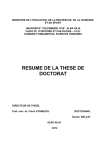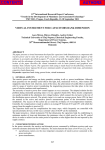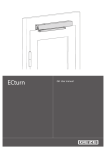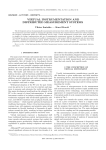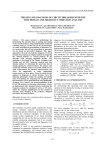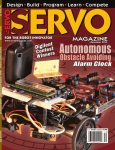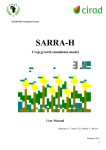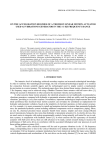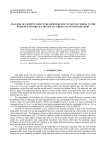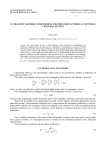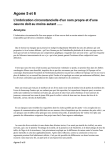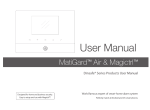Download USING LOW POWER TURBINES IN AREAS WITH - Energy-CIE
Transcript
JOURNAL OF SUSTAINABLE ENERGY VOL. 4, NO. 3, SEPTEMBER, 2013 USING LOW POWER TURBINES IN AREAS WITH LOW WIND POTENTIAL JOIAN R. *, HORGOŞ M. **, PETRUŞ D.*, PALAGHIŢĂ N.* * Technical University of Cluj-Napoca ** Technical University of Cluj-Napoca, North University of Baia Mare Centre [email protected] Abstract - This paper presents some low-power wind turbine solutions that can be used in areas with low wind potential. Statistics are presented in relation to wind speed and direction, measured into a location close to the city of Baia Mare. These data were plotted in order to find the most favorable periods in the range from 2008 to 2012. For performance evaluation of the proposed wind turbine systems, in addition to the technical specifications provided by the manufacturers, we have developped a set of simulations, using programs dedicated to wind systems. Was performed experimental measurements on a wind turbine power d emic belonging to the Technical University of Cluj-Napoca, North University of Baia Mare Centre. Keywords: small power wind turbine, wind potential, graphical representation. 1. INTRODUCTION Wind energy occurs due to potential differences in heat in the troposphere barrel respectively, differences that are caused by uneven heating of the atmosphere. Wind farms are those that currently play a decisive role in producing electricity with wind as the main element. In the early 1980s he began energy development in this area, initially using generating hundreds of kW/unit. Currently power is somewhere in the neighborhood of 7-8 MW/unit. There are two parameters, the basic design and operation of wind farms, namely: • useful speeds (vu) - data time beating the wind, which can be constant or increasing. These rates are higher than the start; • minimum speed (v0) - generally 3 m /s is the minimum speed to drive wind turbines. There are a limited number of areas where wind turbines can be placed large. Our country's wind potential, following some estimates amounts to about 30.000 MW. In about half the territory, the wind is blowing at a speed of at least 3 m/s, and a duration exceeding the figure of 3.500 hours/year. At the end of 2012, Romania had installed almost 2.000 MW wind, according to the SEPS. For the end of 2013 is expected to total installed capacity of 4.000 MW and opinions Transelectrica has applications for 30.000 MW Wind turbines (connection permits were issued for about 8.000 MW), although the system supports more than 5.000 MW. Most wind energy production in Romania was reached on 08.01.2013 at 5.09, when turbines produce 1586 MWh (green graphics), while nuclear energy production (red graphic) amounted to 1.421 MWh in 1184 hydrocarbons MWh (graphically yellow) and water to 395 MWh (blue graphic). Fig. 1. Distribution of solar radiation in the atmosphere Fig.2. Graphic electricity production Wind is an inexhaustible source of energy, so by installing wind turbines, can be transformed into different forms of energy. Sun warms the Earth, so heated air masses will move vertically because the density decreases, thus creating air pockets. Air pressure is greater in cold areas of the Earth. Winds are formed in nature tend to equalize, so cold air masses moving to areas with hot air. Wind turbines are placed on wind direction, which generally must have constant speed in that area. Known so far is that only a certain proportion of the potential wind is received by the facility, which depends on the area on which a wind impeller cover and the efficiency of the wind generator (so called by using the wind speed ratio). In conclusion we can say that the potential of wind power depends on three important factors: size of the installations, installed power, wind speed. ISSN 2067-5534 © 2013 JSE JOURNAL OF SUSTAINABLE ENERGY VOL. 4, NO. 3, SEPTEMBER, 2013 2. DETERMINATION OF THE CITY TĂUŢII MĂGHERĂUŞ WIND POTENŢIAL Wind possess certain physical characteristics: speed, intensity, direction, time distribution. The parameters used for the calculations for the nominal value of a wind power cut, and the area where we could implement a plant or a wind farm. A measure wind speed is an important operation in case of power a wind farm that is proportional to the wind speed cubed. Measuring physical characteristics of wind anemometer is made, which are usually placed on pillars at a height of 50 m . The main types of anemometers are placed radially anemometer hemisphere - the most used, anemometer with ultra-sound - use this to propagate in different environments. According to a study done in our country, to determine the wind potential of Romania. In this analysis we used specific software, meters, etc. In the analysis we used data from 22 stations in the NAM community. The parameters considered are: speed and direction. To study potential wind around Baia Mare, used personal portable anemometer PCE - A 420. From measurements made in the Baia Mare city Tăuţii Măgherăuş an amateur radio mast with a height of about 40 m, located in the open, the following values were determined: Restore the chart to represent multiannual monthly average speed during January 2008 - November 2012, in m/s (Fig. 6). Fig.6 Graphical representation of mean monthly multi (m/s) According to the two graphs we see that the measurements were made in an area with low wind potential. There are maximum measured values in just two months, otherwise gears spinning in the same values. Usually a minimum speed drive wind is 3 m/s. However, we propose a suitable solution for existing data. ASCOR Ecoterm LLC, based in Scorteni, Prahova County, sells low-power turbines whose minimum starting speed is 2 m/s. Technical characteristics for two turbines that can be used given the data collected are presented in Table 1. Incluxiv prices include VAT, shipment and installation. Model wind turbine Rated (W) Nominal Voltage (V) Rotor Diameter (m) Starting wind speed (m/s) Rated wind speed (m/s) Wind speed safety (m/s) Rated speed (rev/min) Material pallets Number of blades column height (m) Diameter pole (mm) Weight turbine (generator assembled with blades and tail) Downwind orientation mode How to over-wind protection Fig. 3. Average wind speed in the period January 2008 - November 2012 Number and capacity batteries Capacity / Inverter / efficiency at maximum Load Regulator Wind turbine SE 500 500 24 2,5 Wind turbine SE 1000 1000 48 2,7 2 8 9 35 400 Fiberglass Reinforced 3 6 89 51 kg 114 59 kg Automatically by the tail Automatic partial or total removal of the wind direction, with the tail depending on the speed of rotation of the rotor 12V 200AH 2 piece 12V 200AH 4 piece 500W/ pure sine / 85% 1000W/ pure sine / 85% The task of dissipating 500W The task of dissipating 1000W continuous intelligence continuous intelligence Packages include: generator blade, pole anchored 6m hybrid drive controller / inverter, batteries for renewable energy applications, cables Package Price 3200$ 4800$ Tab.1 Proposed turbine purchase Fig. 4. Frequency of wind direction in January 2008 November * 2012 In figure 5 is shown graphically interpretation multiannual monthly average speed between January 2008 - November 2012, expressed in km/h. 3. EXPERIMENTAL LOW-POWER WIND TURBINE 3.1 Modeling a 1 kW wind turbines The mathematical model is presented in figure 7 and the settings of the model parameters are shown in figure 8. The model is based on the power characteristics of the turbine steady state. Power output of the turbine is given by the following equation: Pm = c p (λ , β ) Fig.5 Graphical representation of mean monthly multi (km/h) ISSN 2067-5534 © 2013 JSE ρA 2 v 3 wind (1) JOURNAL OF SUSTAINABLE ENERGY VOL. 4, NO. 3, SEPTEMBER, 2013 where: Pm Mechanical output power of the turbine (W) cp Performance coefficient of the turbine ρ Air density (kg/m3) A Turbine swept area (m2) vwind Wind speed (m/s) λ Tip speed ratio of the rotor blade tip speed to wind speed β Blade pitch angle (deg) Fig.9. The law of variation of wind speed Fig.10. Speed wind turbine Fig.7. Simulink model of wind turbine Fig.11. Turbine torque 3.2 Testing and experimentation of a turbine 400W Fig.8. Choice of parameters The two inputs of the model are speed generator (pu) and wind speed in m/s. The output shaft torque applied to the generator. Figures 9 and 10 show the evolution of the profile considered input quantities. Figure 11 shows the result of simulation model of wind under these conditions. AirX wind turbine is classified as low-power turbines and incorporates a microcontroller to sea load performance of batteries and reduce noise. AirX can charge battery systems from 25 to 2500 Ah. When the batteries have reached predetermined load condition AirX wind turbine will cease to have power and restart charging when battery discharges below the set voltage. Also in the event of storm damage to prevent the turbine is equipped with a braking system if wind speed increases above 49.2 m/s. Power available at the terminals of the wind turbine is proportional to the cube of the wind speed according to the relation: P= 1 ρ ⋅ A ⋅ v 3 [W ] 2 (2) This means that every time the wind speed doubles the power increases eight times. AirX unique profile is such that they can take full advantage of wind power. AirX uses a microcontroller to track the maximum power efficiency ISSN 2067-5534 © 2013 JSE JOURNAL OF SUSTAINABLE ENERGY VOL. 4, NO. 3, SEPTEMBER, 2013 curve be appropriate, depending on the available energy getting wind maximum power generated. Test 2 : For this test link Newmax batteries in series and connected to the control panel to stand with correct polarity (terminal (+) of the battery terminal (+) of the array, ie as and negative terminals. Breaker in the electrical panel by operating the turbine feeds power stand. Currently LED is mounted at the bottom of the turbine blinked twice which indicates proper functioning of the controller. If the LED is not blinking when turbine is connected the batteries we would be shown a failure of the controller. Test 3 : Fig.12. Graphics power Maximum power is achieved by continuously adjusting the generator load and keeping the blades at an optimum angle of attack (with vane system) at all wind speeds. Such a turbine although the turbine AirX provides a small amount of energy. Experimentals stand has mounted in the laboratory L-27 North Center University of Baia Mare. In this lab we are able to produce a current of air that trigger turbine. Airflow is produced by a fan driven by a motor connected to a drive. By changing the frequency of the supply voltage of the motor changes its speed and thus airflow speed that we can measure anemometer. For starters, check turbine if mechanical or electrical defects. From the mechanical point of view it is intended that the turbine is also clamped to the pillar rotor blades are attached and secured against accidental loosening. Fan housing not cracks or cracks that could lead to its dissolution during operation. This test requires a way to spin the turbine rotor speed of 500 rev/min. In the absence of rotor spinning device that I use the fan. I set the fan speed in order to obtain an air flow to spin the turbine rotor over 500 rev/min. The turbine is connected to the load consists of two batteries and turns on the fan, when the turbine rotor starts rotating increasingly faster. LED lights often (10 times per second) until the turbine rotor exceeds 500 rev/min at which time the LED lights continuously which indicates the start of charging batteries. After performing tests results presented above that the Air-X turbine tested in terms of electrical functioning properly. 3.2.1 Air turbine operating modes - X 3.2.1.1 Load operation Been sitting idle for doing so: Output terminals not connected load, the turbine remains open circuit. He receives power from speed variator speed fan and grew until I got an airflow speed of 4 m/s at which the turbine rotor began to rotate. I gradually increased fan speed and thus airflow speed. With the circuit breakers voltmeter to monitor voltage stand at different air flow speeds and the data obtained are listed in Table 2. Tab.2. Experimental results running on empty Figure 14 was drawn chart with data obtained above. Fig.13. Experimental stand operation As I tested electrically Air-X turbine follows: Test 1: For this test will proceed as follows: - short circuit terminal (+) and Negative (-) on the control panel of the stand - turbine rotor rotates by hand Following this test it was found that the rotor opposes some resistance to turning his meaning as specified in the user manual Air-X turbine generator that it is good. ISSN 2067-5534 © 2013 JSE Fig.14. Load turbine operation JOURNAL OF SUSTAINABLE ENERGY VOL. 4, NO. 3, SEPTEMBER, 2013 3.2.1.2 Circuit operation The terminals is carried out on the instrument stand and started from low revs fan of it. We found that the airflow speed up to 6 m/s the turbine rotor does not rotate, and if we increased airflow speed to 12 m/s it rotates very slowly. This mode of operation is recommended by the manufacturer without a load. 3.2.1.3 Normal operation Coupled to a load consisting of two 12 volt batteries connected in series to get 24 V nominal voltage of the turbine. We started the fan and its speed was increased progressively changing frequency voltage with frequency converter. Airflow velocity was measured using anemometer at a distance of 1.5 m in front of wind speed at different values. During battery charging control LED light turbine issued. We monitored the load voltage and current at different values of air flow. Values have been obtained in table 3. Curve obtained experimentally is essentially comparable to schedule power user's guide Air-X turbine outlined by the manufacturer. 3.2.1.4 Regulated mode operation In this experiment we followed the behavior of the turbine when the battery voltage reaches 28.2 V preset by the manufacturer. To obtain this value we proceeded battery voltage as follows: • I set the fan speed in order to obtain an air velocity of 13 m/s because this value we obtained the largest turbine power cut; • I connected load consists of battery output terminals of the switchboard; • With voltmeter I monitored battery voltage and the values we went in Table 4: Tab.4 Experimental results running on a regulated Battery charge chart is shown in Figure 16: Tab.3. Experimental results normal Figure 15 was drawn according to schedule power airflow velocity values in Table 3. Fig.16 Battery charge chart When the battery voltage has reached the preset value of 28.2 V turbine rotor speed to brake suddenly became very small. LED - flashes turbine control software often 10 times per second which means that the turbine operates in the regulation. Fig.15. Graphics power 4. CONCLUSION The graph in Figure 14 was drawn with the values obtained in the laboratory. Airflow velocity was measured with anemometer and power is obtained indirectly from the measured values of voltage and current according to the formula P = UI [W] where: Uvoltage [V], I-current [A]. Airflow speed of 4 m/s the turbine starts and has started to generate energy. Energy generated increases with increasing airflow speed and reaches the maximum when the air flow velocity is 13 m/s, the load voltage is 27.8 V, the load current is 12.59 A. If you increased current velocity air at 14 m/s brake rotor to a low speed and the energy generated by the turbine drops to near zero, however I increased slightly increasing airflow speed. This is regulated by the embedded controller and protect against damage to turbine wind speeds. We determined the wind potential in a real location, and obtained from Daelim proposed a system to suit locations monitored. At the same time and graphs were plotted for the results of measurement of the direction and intensity of the wind. We analyzed two small wind power systems, as follows: • modeling unuei 1 kW turbines under existing Simulink model, determining the law of variation of wind speed wind turbine wind turbine torque. Wind turbine AirX – 400 He built an experimental stand which gives us the possibility that under laboratory conditions to produce various operating conditions of wind turbines. ISSN 2067-5534 © 2013 JSE JOURNAL OF SUSTAINABLE ENERGY VOL. 4, NO. 3, SEPTEMBER, 2013 There have been a number of three tests with which we concluded that the turbine Air-X 400 is functional in terms of power. After testing we performed the following simulations turbine operating mode of the turbine Air X 400: Operation empty cage operation, operation type (the most important mode) operation mode regulators. The most important experiment is one in which the turbine was working normally, energy debiting task consists of two batteries. The data obtained were transferred to a table, with the aid of the power to represent the chart.. The interpretation of graphs, resulting: • startup speed of the turbine is 4 m/s, the manufacturer indicating that the starting speed value 3.58 m/s; • air flow speed of 13 m/s maximum power produced by the turbine is and has the value P = 350 [W]. Maximum power specified by the manufacturer is 400 [W] at a wind speed of 12.5 m/s; • When the airflow speed reached 14 m/s turbine to brake without stopping completely and ceased to produce energy. Wind speed at which turbine significantly reduce their speed specified in the user manual Air-X turbine is 15.6 m/s. In the laboratory we could not get the airflow speed of 49.2 m/s, the turbine speed would be slowed total if turbine would not stop at high wind speeds would destroy it. If I charged the batteries for about 3 hours on battery voltage exceeded 28V and turbine began operating in the regulation ceased to charge the battery energy. Because of this risk is not Overcharging REFERENCES [1] Thomas Patara - Contributions to the analysis and design of micro-renewable energy networks, PhD thesis, Cluj - Napoca, 2012. [2] Ionela Negrea - Adaptability study of low-power wind turbines to the climatic conditions of Romania, PhD thesis, Braşov, 2010. [3] John Costin Coşoiu - Contributions to optimize the design and operation of wind generators, PhD thesis, Bucharest, 2008. [4] Iulian Munteanu - Contributions to the optimal management of wind energy conversion systems, PhD thesis, Galaţi, 2006. [5] Roman Baican - Energy regenrabile Publishing Grinta, Cluj - Napoca, 2010. [6] Mihai Octavian Popescu, Claudia Laurent Smith Renewable Energy, Volume 1: Principles and Applications, Electra Publishing, Bucharest, 2010. [7] Niculaie Palaghita, Petreuş Dorin Cristian Farcas Power Electronics, Volume II Mediamira Publishing House, Cluj - Napoca 2004. [8] Niculaie Palaghita, Petreuş Dorin Cristian Farcas Electronics Command and Control, Ed Mediamira, Cluj Napoca 2004. [9] Chindriş, M., Cziker, A., Miron, Anca, Tomoiagă, B. energy management. Applications, Publishing House Book of Science, Cluj-Napoca, 2009. [10] Victor Emil Lucian - Renewable resources and their conversion, MatrixRom Publishing House, Bucharest, 2011. ISSN 2067-5534 © 2013 JSE






